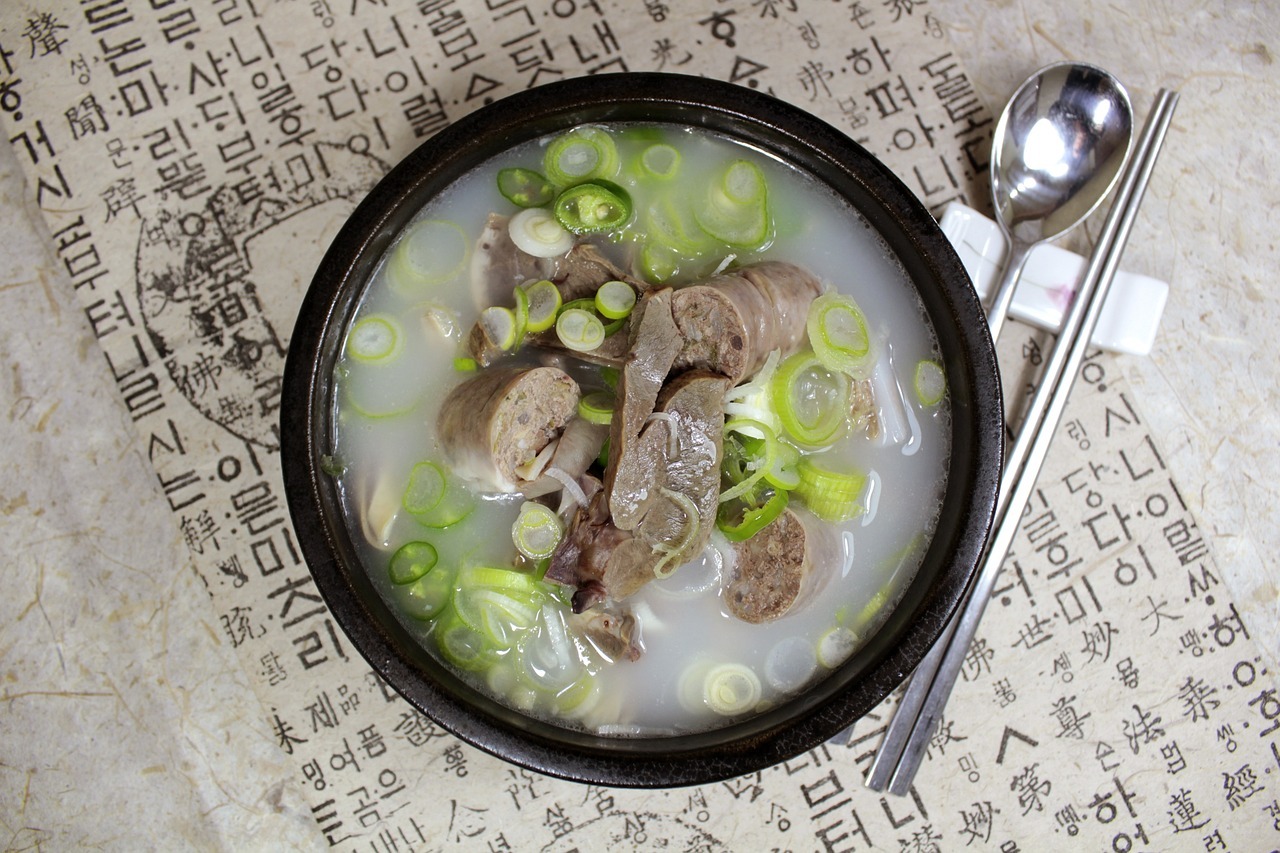해장국 Alternate spellings: Haechangkuk This is a thick, spicy, and very hearty soup made from ox (beef) bone broth with soybean paste (doenjang), soybean sprouts, white radish, green onions and sometimes ox blood. Also called early morning soup or hangover soup, this is a very traditional home-style dish often eaten after a night of heavy drinking.
Servings
Servings: 6
Ingredients
First Boil
4 pounds Pork Spine or neck bones with meat on
8 cups water
Tools: To perfect cut all ingredients and vegetables we recommend the best Japanese Knife.
Simmer Ingredients
Spine bones from first boil
1 cup doenjang (Korean miso) paste
1 medium white onion
6 cloves garlic
8 cups unsalted beef broth
1 large green onion (white only – reserve the green for third boil)
1 ounce peeled ginger
10 whole or cracked (not ground) black pepper seeds
Boil
Spine bones from previous steps
Broth from “simmer step”
1 small Korean “white” radish (Daikon) (about 1 pound)
8 outer leaves of napa (Chinese) cabbage
4 ounces dried gosari (fern brakken, fern sprouts)
8 cloves garlic
2 green chile peppers (mild)
1 or 2 red chile peppers (hot)
2 tablespoons gochujang (red pepper paste)
2 oz neutari beoseot 느타리버섯 (oyster mushrooms)
3 or 4 pyogo beoseot 표고버섯 (shiitake mushrooms)
4 tablespoons medium or fine ground red chile pepper
1/2 pound soy bean sprouts
Final
6 green onions + the reserved green from the “simmer” step
2 ounces paengi beoseot 팽이버섯 (enoki mushrooms)
Optional
1/2 cup clotted ox(beef)blood
1 teaspoon salt
1/2 cup water
Procedure
Directions
First Boil
Place spine bones in a large cooking pot and cover with cold water.
Soak for two hours, rinse, and drain (discard soak water).
Cover bones with water and bring to a boil over high heat.
Boil for about five minutes, remove from heat, and discard boil water.
Rinse bones in cold water and drain.
Simmer
Preparation
Spine Bones
Rub the bones with the doenjang paste and let sit for ten minutes.
Vegetables
Cut onion in quarters
Peel and slice ginger into two or three pieces
Cut garlic cloves in half from top to bottom
Slice the white section of the green onion in half from top to bottom.
Cook
Place spine bones in large pot and cover with beef broth.
Bring to a slow boil, then reduce heat to a simmer.
Add all other simmer ingredients.
Simmer for two hours, adding water as needed to maintain 3/4 the original liquid volume.
Carefully remove bones from broth, then strain the broth into a second cooking pot.
Discard vegetable solids strained from the broth.
Third Boil
Preparation
Gosari
Soak dried gosari for about 30 minutes to one hour in cold water.
Rinse and drain.
Korean “white” radish
Cut in slices about 1/2 inch thick.
For thicker radish, cut in half or quarters from top to bottom first.
Napa (Chinese) cabbage
Rinse well in cold water.
Cut leaves into strips about 3/4 of an inch wide by 2 inches long.
Garlic
Slice garlic in half or thirds from top to bottom.
Chile peppers
Slice chile peppers on a diagonal.
Neutari beoseot (oyster mushrooms)
Cut into bite sized pieces
Pyogo beoseot (shiitake mushrooms)
If dried – rinse well in cold water, then reconstitute in 1/2 cup beef broth.
Cut fresh or re-hydrated mushrooms in half.
Soy bean sprouts
Rinse well in cold water.
Optional clotted blood
Place blood, water, and salt in a mixing bowl and mix well.
Cook
Place spine bones back into cooking pot, add strained broth, (and optional blood mix) and bring to a medium boil
Add sliced radish and gosari, cook for three to five minutes.
Add remaining ingredients and cook another five minutes.
Reduce heat to low.
Final
Separate paengi beoseot (enoki mushrooms) into small bunches. (one bunch per serving bowl)
Cut green onions into about 1 1/2 inch lengths.
CAREFULLY place some of the spine bones in each serving bowl
Use a slotted spoon and place cooked vegetables in each serving, on top of the bones.
Place green onion and paengi on top of the vegetables.
Ladle simmering broth over the meat and vegetables in each bowl.
Turn off heat under the soup pot
Serve with steamed white rice and ban chan.
Tips
Shopping List For Haejangguk
4 pounds 돼지 목에 뼈가 (Pork Spine or neck bones with meat on)
된장 doenjang (soybean paste)
고추장 gochujang (red pepper paste)
고춧가루 (gochutgaru – red chili pepper powder)
1 양파 medium onion
2 마늘 maneul (garlic)
8 cups unsalted beef broth
생강 saenggang (1 ounce ginger)
10 후추 whole or cracked (not ground) black pepper seeds
1 무 Mu (Daikon or White radish) (about 1 pound)
1 배추 baechu (napa or Chinese cabbage )
고사리dried gosari ( 4 ounces fern brakken, fern sprouts)
2 빨강 고추 (red chili pepper – gochu)
2 녹색 고추 (green chili pepper – gochu)
느타리버섯 neutari beoseot (2 ounces oyster mushrooms)
표고버섯 pyogo beoseot ( 3 or 4 shiitake mushrooms)
1/2 pound 콩나물 (kongnamul – soy bean sprouts)
7 파 pa (green onions )
팽이버섯 paengi beoseot ( 2 ounces enoki mushrooms)
Optional
1/2 cup clotted ox(beef)blood
salt
